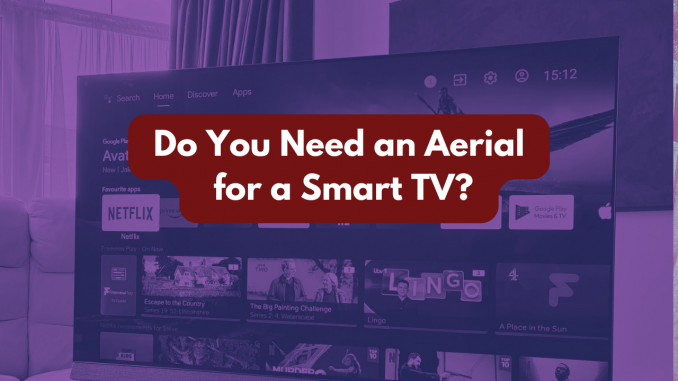
Smart TVs have become an integral part of many UK households. These types of TV offer a seamless blend of traditional television programming and internet-based content streaming, with apps like Netflix & Disney +, transforming the way we consume entertainment.
You don’t need an aerial if you’re content with streaming services and online entertainment, as an internet connection suffices. If you want to access traditional broadcast channels live, then an aerial is is needed to watch these live without a delay.
In essence, Smart TVs offer a versatile entertainment experience that combines the best of both worlds: internet-based content and over-the-air broadcasts. Without an aerial however, any live TV you stream via the internet will experience a delay. Assess your preferences and requirements to determine whether an aerial is a must-have addition to your Smart TV setup.
Smart TVs vs. Traditional TVs
Before we dive into whether an aerial is required for a Smart TV, let’s briefly differentiate between Smart TVs and their traditional counterparts. A traditional TV relies on broadcast signals received through an aerial to display over-the-air channels. Smart TVs, on the other hand, are equipped with internet connectivity and integrated apps that allow access to a plethora of online streaming services, including Netflix, Amazon Prime Video, BBC iPlayer, and more. This internet-based content doesn’t require an aerial connection to function.
What is the difference between streaming TV and aerial TV?
Streaming TV: Streaming TV delivers content over the internet. Viewers access streaming services through apps or websites on various devices like smartphones, tablets, smart TVs, streaming media players, and computers. Content is delivered on-demand, and viewers can choose what they want to watch and when.
Aerial TV: Aerial TV, on the other hand, relies on traditional broadcasting infrastructure. It uses radio waves to transmit television signals over the air to an antenna on the viewer’s TV set. This method has been in use for decades and is typically received via an antenna (either indoor or outdoor).
In summary, streaming TV is delivered over the internet, offers a wide range of content, and requires a subscription fee, while aerial TV is received via traditional broadcasting, provides free-to-air channels, and requires a TV and antenna. The choice between the two depends on individual preferences, location, and viewing habits. Many people use a combination of both to access a broader range of content.
Broadcast Television and Aerials
While Smart TVs provide access to online content, many viewers still appreciate the convenience of traditional broadcast channels. Local news, live sports events, and special broadcasts often air on these channels. To access these over-the-air broadcasts, an aerial is required. The aerial captures the terrestrial signals and transmits them to the TV, allowing you to enjoy a mix of both traditional and online content.
The world of Smart TVs opens up a realm of entertainment possibilities without the need for an aerial socket / cable. Whether you’re binge-watching the latest series on a streaming platform or tuning in to live TV broadcasts, it’s a lot easy to tailor and move your Smart TV to your preferences, and enjoy the best of modern entertainment right from the comfort of your home.
What Is a TV Aerial?
A TV aerial, also commonly known as an antenna in the United States, is a specialized device designed to capture television broadcast signals that are transmitted over the air. These signals carry both audio and video information and are sent out by television stations, making it possible for us to enjoy our favorite TV shows, news, sports, and more. The TV aerial is the gateway that allows these signals to be received and processed by your television.
How Does a TV Aerial Work?
The functionality of a TV aerial is based on a few fundamental principles of electromagnetic waves. Here’s a simplified overview of how it works:
- Signal Capture: TV aerials are installed on structures such as roofs or poles. When television stations transmit their signals, these signals are propagated as electromagnetic waves. The TV aerial’s main task is to capture these waves and convert them into electrical signals.
- Conversion: The captured electromagnetic waves contain information in the form of radio frequency (RF) signals. The TV aerial’s components, such as its antenna elements, are designed to receive these signals and convert them into electrical currents.
- Transmission to TV: Once the electrical signals are generated, they are sent through coaxial cables or other wiring to your television set. The TV’s tuner then processes these signals, translating them into the audio and visual content you see and hear on your TV screen.
Types of TV Aerials
TV aerials come in various types and designs, each tailored to specific needs and signal frequencies. The two primary types of TV aerials are:
- UHF (Ultra High Frequency) Aerials: UHF aerials are designed to capture higher-frequency television signals. They are commonly used for digital terrestrial television broadcasts in many regions. UHF aerials are generally smaller and more compact in design.
- VHF (Very High Frequency) Aerials: VHF aerials are used to capture lower-frequency television signals, which were prevalent in analog television broadcasts. They tend to be larger and are less commonly used in areas with digital broadcasting.
In addition to these basic types, there are specialized aerials available for specific purposes. For instance, high-gain aerials are used in areas with weak signals, and some aerials come with built-in signal amplifiers to enhance signal strength.
The Transition to Digital TV
With the transition from analogue to digital television broadcasting in many countries, including the United Kingdom, it is crucial to use a digital-compatible TV aerial to receive digital television signals. Digital broadcasting offers improved picture and sound quality, as well as additional channels and features. Using an outdated analogue aerial in a digital broadcasting environment may result in poor signal quality or no reception at all.

Leave a Reply